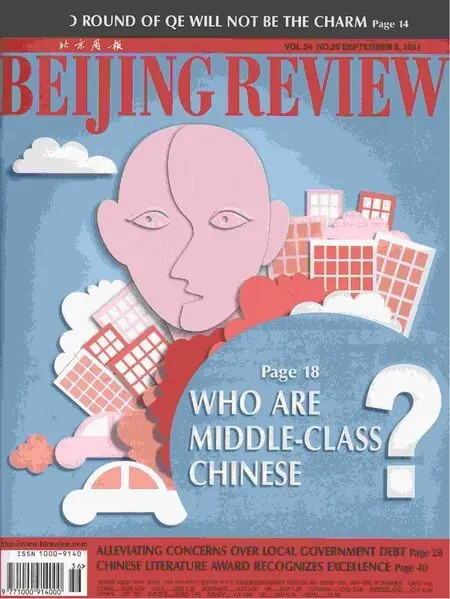Dreaming of China
2011-10-14ByLIUXINLIAN
By LIU XINLIAN
Dreaming of China
By LIU XINLIAN
DreamWorks plans to set up a studio in China

From Disney’sMulanin 1998 to DreamWorks’Kungfu Panda, cartoon characters originating from Chinese legends have become a trump card for the success of animation movies from Hollywood.
DreamWorks CEO Jeffrey Katzenberg said their third quarter earnings were largely driven by the international box offce success ofKungfu Panda 2, the number one grossing animated movie of the year and the fourth highest-grossing film worldwide.Kungfu Panda 2in China alone raked in more than 600 million yuan ($94.49 million).
Katzenberg described the panda movie as DreamWork’s love letter for China and said he will make more China-themed animations to pay tribute to China.
Moreover, DreamWorks is going to establish a permanent presence in China.
Beijing-based business magazineCaijingrecently reported that DreamWorks plans to set up a joint venture studio in Shanghai as early as January 2012, with China Media Capital, Shanghai Media Group and other strategic investors.
A spokeswoman for DreamWorks said,“As it is an important market for us and one in which the DreamWorks Animation brand and products have tremendous value, we continue to explore opportunities in China.”
According to the State Administration of Radio, Film and Television, China’s box offce in 2010 topped 10 billion yuan ($1.57 billion), growing by 64 percent compared to 2009. And China ranked 10th among the world’s flm markets, according to the2011 Blue Book of China’s Cultureissued by the Chinese Academy of Social Sciences.
Han Sanping, President of the China Film Group, said China’s box office is expected to reach 13.5 billion yuan ($2.13 billion) this year and 30-35 billion yuan ($4.72-5.51 billion) in the next fve years.
While tapping the Chinese market will prove difficult, DreamWorks is optimistic. Having a small presence is better than having no presence in the world’s fastest growing flm market.
Chinese determinants
When it comes to the Chinese animation market, Disney’s dominance has left little room for competitors.
Since Disney’s flagship characters Mickey Mouse and Donald Duck made their debut on China’s state-run CCTV in 1986, the international entertainment giant has set up three branches on China’s mainland.
On April 8, Shanghai Disneyland broke ground and is slated to open by 2016. Disney already has a theme park in Hong Kong, making China the first country outside the United States to boast two of the worldrenowned resorts.
Today Disney’s business in China covers movies, publications, franchised products, ice rinks, language schools and resorts.
While Disney is trying to introduce its U.S. cartoon characters and products to China, DreamWorks is obviously taking another path.
DreamWorks has been a master of telling stories about China by integrating Chinese elements and international views.
Katzenberg said that he has been reading Chinese fairy tales and draws inspiration from them.
DreamWorks has been and will bring the cartoon characters originated from Chinese culture to the world, saidCaijing.
In the new studio, which will be set up in Shanghai with Chinese investors, the Chinese side will have a controlling stake, according toCaijing.
The joint venture will focus on technology research and development and also cooperate with Chinese film companies to co-produce animated feature flms that cater to the Chinese market.
The joint venture will invest a total of $2 billion over the next fve years, which will be shared equally by DreamWorks and its Chinese partners.
DreamWorks may use the success of itsKungfu Pandaflm series as subject matter for the studio and it plans to release its first blockbuster animated feature in 2015, according toCaijing.
Mixed feelings
DreamWorks’ move also upset some in China’s burgeoning animation industry, who are wary of the invasion of yet another international megacorporation, but others think domestic companies can beneft from the partnership.
Although domestic animation movies made before the 1980s, such asThe Monkey King, are thought of as masterpieces by fans today, China’s animation industry is still weak.
China currently has some 10,000 companies making cartoons and comics. But besides thePleasant Goat and Big Big Wolfand the Mainland-Hong Kong co-productionMcDull,Kungfu Kindergarten, other animated flms fared poorly at the box offce.
A poll by theChina Youth Dailyin November 2008 showed that only 14.2 percent of the nearly 3,000 people polled liked Chinese cartoons.
By contrast, 62.4 percent of respondents said their favorite animated flms were made in the United States and 45.9 percent favored flms from Japan.
Xu Ke, President of Hippo Animation Design Co. Ltd. based in Shanghai called the entry of DreamWorks “catastrophic” for the domestic animation industry.
“China’s animation industry lagged far behind Hollywood for several decades,” Xu told China National Radio (CNR).
“The international heavyweights boast advantages in capital, talents, marketing and distribution, almost all phases in the animation industry. No domestic counterparts could compete with them,” said Xu.
China’s animation flm industry is in its infancy, Wang Lei, CEO of Shanghai-based Mr. Cartoon, a provider of children’s and family flms, toldCaijing.
“I don’t think China’s animation industryhas made any progress in spite of the surging number of professionals in recent years. It is only about quantity, not quality,” he said. The industry now employs more than 200,000 workers, according to a report from the Ministry of Culture,

LAN XIANGYAN
The gap between Chinese and Western animation exists throughout the production chain, Wang said.
“It will take at least 10 to 15 years for China to produce an animation masterpiece comparable toKungfu Panda,” said Hu Zongjing, General Manager of Animation Department of Uyoung Media based in Beijing.
However, DreamWorks’ presence in China may offer an opportunity for the country’s animation industry to develop.
“DreamWorks’ big investment in China will necessarily cultivate a slew of animation professionals who will eventually promote the indigenous industry,” said Hu.
“An enclosed market does not necessarily guarantee booming industry. This is particularly true in the cultural industry,”Xiao Yongliang, Vice Dean of School of Arts and Communication at the Beijing Normal University, told CNR.
“The entry of DreamWorks will force domestic animation makers to stand up to competition, which will promote their team training and marketing,”Xiao said.
Even so, DreamWorks’ success in China is far from certain, despite the popularity of the characters DreamWorks created among the Chinese audience.
Media tycoon Rupert Murdoch’s investment in China did not unfold as expected. In 2002, News Corp.’s Asian satellite service Star TV received approval for its new local unit, Xing Kong, to broadcast in China. Today, audience figures have failed to breach seven digits, much smaller than domestic channels.
The lessons of those forerunners raises doubts over whether DreamWorks will be the exception.
